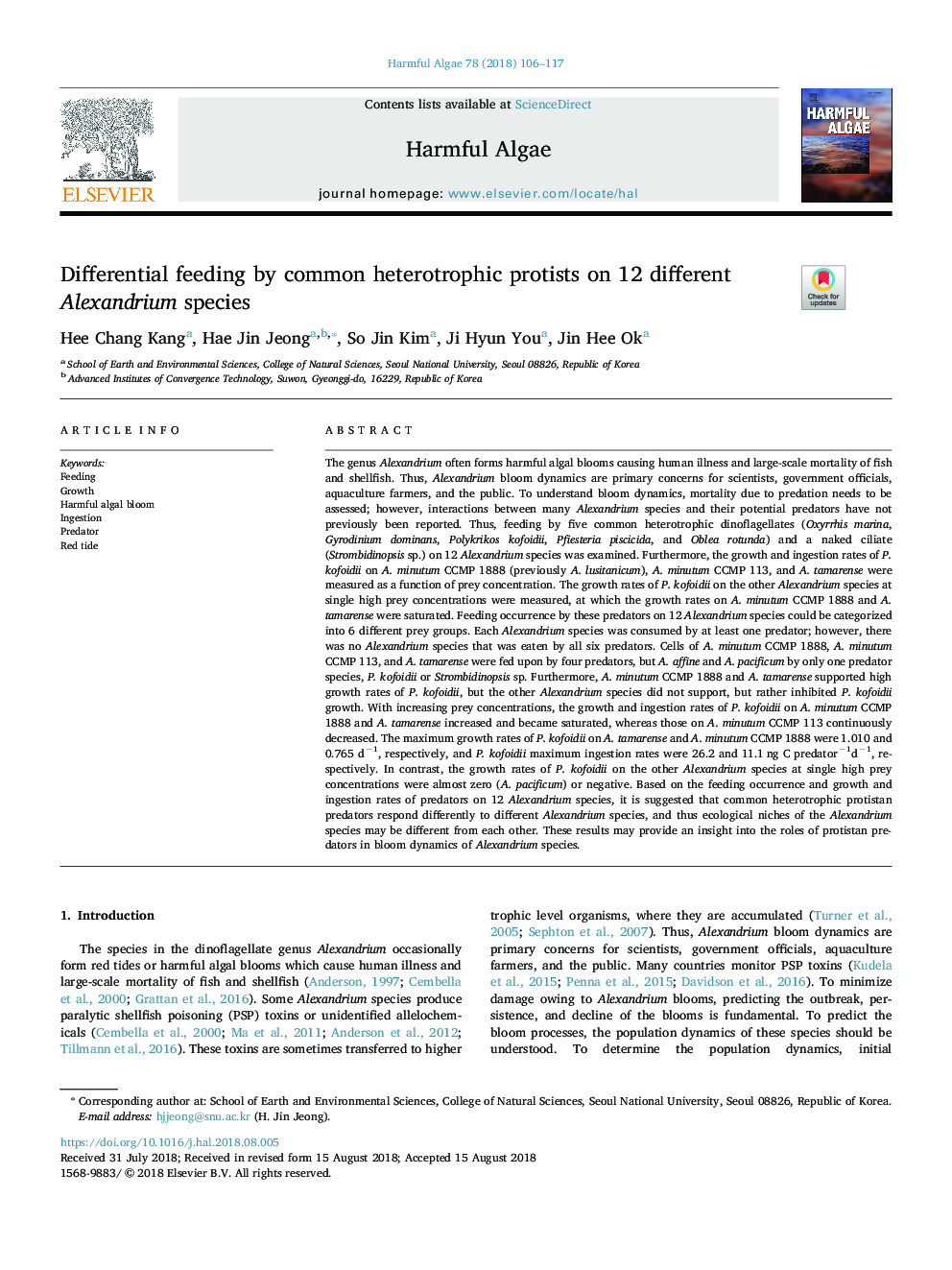| کد مقاله | کد نشریه | سال انتشار | مقاله انگلیسی | نسخه تمام متن |
|---|---|---|---|---|
| 8885631 | 1626894 | 2018 | 12 صفحه PDF | دانلود رایگان |
عنوان انگلیسی مقاله ISI
Differential feeding by common heterotrophic protists on 12 different Alexandrium species
ترجمه فارسی عنوان
تغذیه دیفرانسیل توسط پروتئین های هتروتروفی مشترک بر روی 12 گونه مختلف
دانلود مقاله + سفارش ترجمه
دانلود مقاله ISI انگلیسی
رایگان برای ایرانیان
کلمات کلیدی
تغذیه، رشد شکوفه جلبک خطرناک، آلزایمر، شکارچی جزر و مد قرمز،
موضوعات مرتبط
علوم زیستی و بیوفناوری
علوم کشاورزی و بیولوژیک
علوم آبزیان
چکیده انگلیسی
The genus Alexandrium often forms harmful algal blooms causing human illness and large-scale mortality of fish and shellfish. Thus, Alexandrium bloom dynamics are primary concerns for scientists, government officials, aquaculture farmers, and the public. To understand bloom dynamics, mortality due to predation needs to be assessed; however, interactions between many Alexandrium species and their potential predators have not previously been reported. Thus, feeding by five common heterotrophic dinoflagellates (Oxyrrhis marina, Gyrodinium dominans, Polykrikos kofoidii, Pfiesteria piscicida, and Oblea rotunda) and a naked ciliate (Strombidinopsis sp.) on 12 Alexandrium species was examined. Furthermore, the growth and ingestion rates of P. kofoidii on A. minutum CCMP 1888 (previously A. lusitanicum), A. minutum CCMP 113, and A. tamarense were measured as a function of prey concentration. The growth rates of P. kofoidii on the other Alexandrium species at single high prey concentrations were measured, at which the growth rates on A. minutum CCMP 1888 and A. tamarense were saturated. Feeding occurrence by these predators on 12 Alexandrium species could be categorized into 6 different prey groups. Each Alexandrium species was consumed by at least one predator; however, there was no Alexandrium species that was eaten by all six predators. Cells of A. minutum CCMP 1888, A. minutum CCMP 113, and A. tamarense were fed upon by four predators, but A. affine and A. pacificum by only one predator species, P. kofoidii or Strombidinopsis sp. Furthermore, A. minutum CCMP 1888 and A. tamarense supported high growth rates of P. kofoidii, but the other Alexandrium species did not support, but rather inhibited P. kofoidii growth. With increasing prey concentrations, the growth and ingestion rates of P. kofoidii on A. minutum CCMP 1888 and A. tamarense increased and became saturated, whereas those on A. minutum CCMP 113 continuously decreased. The maximum growth rates of P. kofoidii on A. tamarense and A. minutum CCMP 1888 were 1.010 and 0.765 dâ1, respectively, and P. kofoidii maximum ingestion rates were 26.2 and 11.1âng C predatorâ1dâ1, respectively. In contrast, the growth rates of P. kofoidii on the other Alexandrium species at single high prey concentrations were almost zero (A. pacificum) or negative. Based on the feeding occurrence and growth and ingestion rates of predators on 12 Alexandrium species, it is suggested that common heterotrophic protistan predators respond differently to different Alexandrium species, and thus ecological niches of the Alexandrium species may be different from each other. These results may provide an insight into the roles of protistan predators in bloom dynamics of Alexandrium species.
ناشر
Database: Elsevier - ScienceDirect (ساینس دایرکت)
Journal: Harmful Algae - Volume 78, September 2018, Pages 106-117
Journal: Harmful Algae - Volume 78, September 2018, Pages 106-117
نویسندگان
Hee Chang Kang, Hae Jin Jeong, So Jin Kim, Ji Hyun You, Jin Hee Ok,
